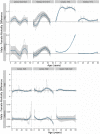Women live longer than men even during severe famines and epidemics
- PMID: 29311321
- PMCID: PMC5789901
- DOI: 10.1073/pnas.1701535115
Women live longer than men even during severe famines and epidemics
Abstract
Women in almost all modern populations live longer than men. Research to date provides evidence for both biological and social factors influencing this gender gap. Conditions when both men and women experience extremely high levels of mortality risk are unexplored sources of information. We investigate the survival of both sexes in seven populations under extreme conditions from famines, epidemics, and slavery. Women survived better than men: In all populations, they had lower mortality across almost all ages, and, with the exception of one slave population, they lived longer on average than men. Gender differences in infant mortality contributed the most to the gender gap in life expectancy, indicating that newborn girls were able to survive extreme mortality hazards better than newborn boys. Our results confirm the ubiquity of a female survival advantage even when mortality is extraordinarily high. The hypothesis that the survival advantage of women has fundamental biological underpinnings is supported by the fact that under very harsh conditions females survive better than males even at infant ages when behavioral and social differences may be minimal or favor males. Our findings also indicate that the female advantage differs across environments and is modulated by social factors.
Keywords: epidemics; famines; gender; mortality; survival.
Copyright © 2018 the Author(s). Published by PNAS.
Conflict of interest statement
The authors declare no conflict of interest.
Figures



Comment in
-
Reply to Delanghe et al.: Iron status is not likely to play a key role in the gender survival gap under extreme conditions.Proc Natl Acad Sci U S A. 2018 May 1;115(18):E4150. doi: 10.1073/pnas.1801481115. Epub 2018 Apr 17. Proc Natl Acad Sci U S A. 2018. PMID: 29666225 Free PMC article. No abstract available.
-
Iron status as a confounder in the gender gap in survival under extreme conditions.Proc Natl Acad Sci U S A. 2018 May 1;115(18):E4148-E4149. doi: 10.1073/pnas.1800932115. Epub 2018 Apr 17. Proc Natl Acad Sci U S A. 2018. PMID: 29666245 Free PMC article. No abstract available.
Similar articles
-
Sex- and age-related mortality profiles during famine: testing the 'body fat' hypothesis.J Biosoc Sci. 2013 Nov;45(6):823-40. doi: 10.1017/S0021932012000818. Epub 2013 Jan 10. J Biosoc Sci. 2013. PMID: 23302114
-
The changing gender differences in life expectancy in Korea 1970-2005.Soc Sci Med. 2012 Oct;75(7):1280-7. doi: 10.1016/j.socscimed.2012.04.026. Epub 2012 May 23. Soc Sci Med. 2012. PMID: 22739261
-
[Extent and impact of the measles epidemics of 1846 and 1882 in Iceland].Laeknabladid. 2014 Apr;100(4):211-6. doi: 10.17992/lbl.2014.04.539. Laeknabladid. 2014. PMID: 24713538 Icelandic.
-
The sex differential in morbidity, mortality, and lifestyle.Annu Rev Public Health. 1984;5:433-58. doi: 10.1146/annurev.pu.05.050184.002245. Annu Rev Public Health. 1984. PMID: 6372818 Review.
-
Longevity in women.Cardiovasc Clin. 1989;19(3):3-16. Cardiovasc Clin. 1989. PMID: 2644037 Review.
Cited by
-
Sex Difference in 5-year Relative Survival Following Percutaneous Coronary Intervention.Eur Cardiol. 2024 Oct 2;19:e18. doi: 10.15420/ecr.2024.25. eCollection 2024. Eur Cardiol. 2024. PMID: 39449722 Free PMC article.
-
Integrating the Memory Support Intervention into the Transdiagnostic Intervention for Sleep and Circadian Dysfunction (TranS-C): can improving memory for treatment in midlife and older adults improve patient outcomes? Study protocol for a randomized controlled trial.Trials. 2024 Oct 3;25(1):650. doi: 10.1186/s13063-024-08468-0. Trials. 2024. PMID: 39363383 Free PMC article.
-
Unveiling the female experience through adult mortality and survivorship in Milan over the last 2000 years.Sci Rep. 2024 Sep 12;14(1):21328. doi: 10.1038/s41598-024-71607-9. Sci Rep. 2024. PMID: 39266601 Free PMC article.
-
Immunogenicity and Protective Efficacy of Dose-Sparing Epigraph Vaccine against H3 Swine Influenza A Virus.Vaccines (Basel). 2024 Aug 22;12(8):943. doi: 10.3390/vaccines12080943. Vaccines (Basel). 2024. PMID: 39204066 Free PMC article.
-
Effects of a high-fat diet on cognition and brain distribution of intranasal insulin in E3 and E4 male and female mice.Sci Rep. 2024 Aug 11;14(1):18641. doi: 10.1038/s41598-024-62053-8. Sci Rep. 2024. PMID: 39128931 Free PMC article.
References
-
- Austad SN. Why women live longer than men: Sex differences in longevity. Gend Med. 2006;3:79–92. - PubMed
-
- Glei DA, Horiuchi S. The narrowing sex differential in life expectancy in high-income populations: Effects of differences in the age pattern of mortality. Popul Stud (Camb) 2007;61:141–159. - PubMed
-
- Kalben BB. Why men die younger: Causes of mortality differences by sex. N Am Actuar J. 2000;4:83–111.
MeSH terms
Grants and funding
LinkOut - more resources
Full Text Sources
Other Literature Sources
Miscellaneous

